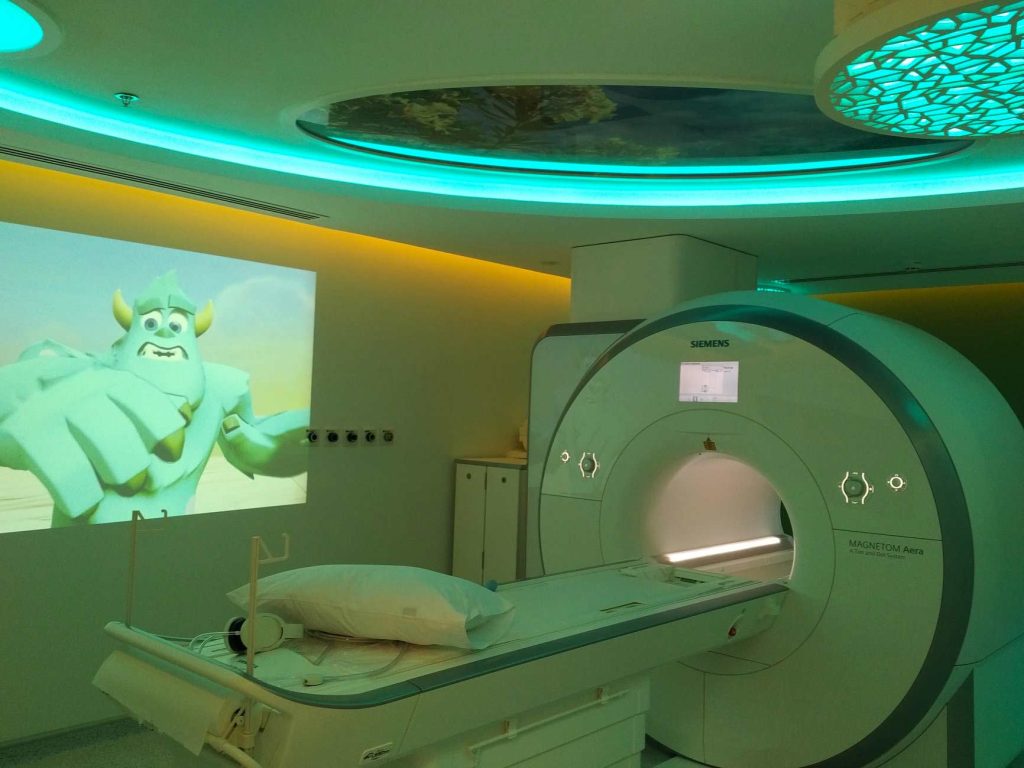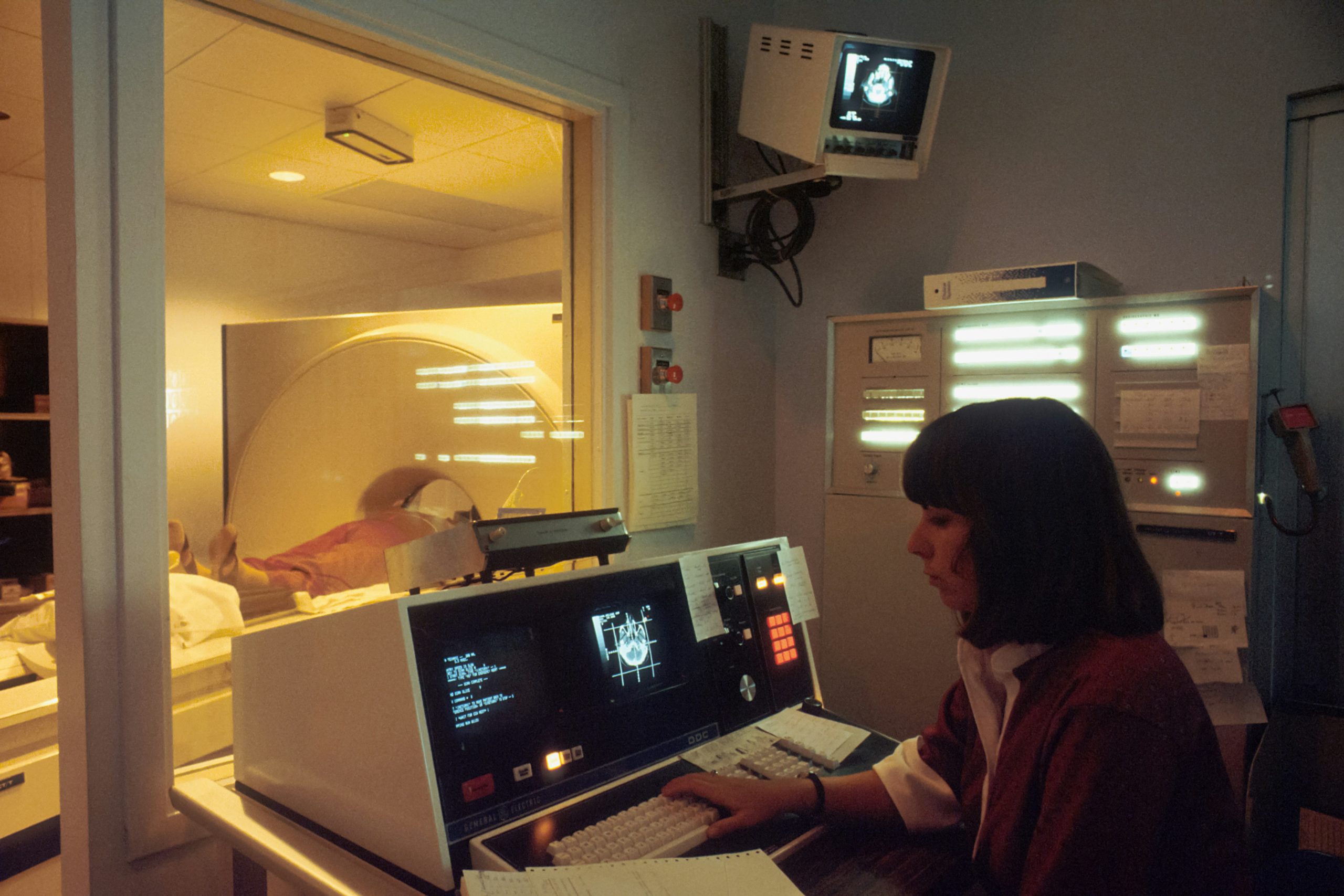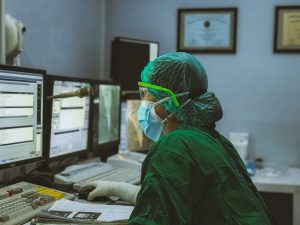Virtual Reality Transforms the everyday MRI experience

Source: https://kryptonite.global/blogs/transforming-patient-healing-with-mri-ambience-technology/
Magnetic Resonance Imaging (MRI) is a medical imaging tool that uses strong magnetic fields and radio waves to create thorough images of structures inside the body. When a patient is placed inside a typical MRI machine, hydrogen atoms in the body position with the magnetic field of the machine. When the radio waves are turned on, the atoms create signals that are distinguished by receivers. A computer then analyzes these signals and converts them into images that show possible abnormalities. MRIs are valuable for identifying irregularities in soft tissues, muscles, spinal cords, joints, and the brain. As time goes on scientists continue to bring better and more efficient ways to use an MRI machine through advancements. MRIs have been used since the 1930’s. Throughout history, the availability and reliability of MRIs has grown expeditiously. From the basis of an MRI called nuclear magnetic resonance (NMR), discovered by Felix Bloch and Edward Purcell enabling an MRI scanner to use the body’s water balance to create MRI images in the 1940s, the finding of the possibility that MRI’s could help cancer patients through differentiating cancer cells because different types of tissue emissions exhibited different response durations; a discovery by Dr. Raymond Damadian, which led him to build the first MRI machine in 1972. MRIs continued to get better and better as time went on, hence 3D images of the body were being created from 1972 through 1980.
On the other hand, a Virtual Reality System(VR), is a technology that creates life-like scenarios through images or videos which creates the illusion or sense of being physically present in the virtual world. The main components of a virtual reality system is a headset that is worn over one’s eyes. Firstly invented in the 1950’s VR systems have grown so much that they are now considered a norm in many households as many began to use them for video games supported by their home 5G networks. As many know it to be, VR systems serve as a fun way for people to interact with “a whole new world”. Therefore, the question becomes, how does a VR system benefit MRI machines?
The large, yet thin cylindrical shape of an MRI machine makes it a difficult structure to feel comfortable in while having to lay still. This difficulty is evident especially within children under the age of 7. During MRI scannings when staying still is very important to ensure the most accurate results, many children find it difficult to stay still as they are in their early stages causing most children to need a sedative such as anesthesia. MRI procedures can be stressful and claustrophobic for patients, and can also be very loud, therefore causing movements/disruptions that can alter the MRI results. Researchers from the school of Biomedical Engineering & Imaging Sciences have created a Virtual Reality System that can now help children stay interactive and distracted, leading to stillness and comfort during MRI scannings. This technology is also a “gaze based human-computer interaction (HCI) system” meaning that it includes an “adaptive gaze estimation model” as stated by the research team. The Virtual Reality system is able to adjust the experience though visualizations such as videos, images, interactive games or educational content, by identifying when exactly the patient is looking at/their gaze. One’s gaze affects their bodily movement. Therefore, when an individual is focused, it is physically reflected as they tend to move less, making the results of the MRI the best that it can be. In the case a patient moves, the Virtual Reality System moves the visualization being shown to their place of focus to maintain focus which then brings forth stillness. This form of gaze control to assist children during MRIs has been tested on 23 children between the ages of 2 to 13. Proving that this distraction for patients works as a great way to keep children grounded during MRIs. Additionally, when it comes to Functional Magnetic Resonance Imaging (fMRI), because it involves cognitive tasks, Virtual Reality visualizations help patients maintain a consistent presentation of external stimuli such as sound and images as that affects brain activity. It is important that the brain activity is controlled to ensure the MRI results are not derailed. The idea of Virtual Reality Technologies during MRI scannings can also be great for research. During neurological research, researchers could possibly identify how brain activity changes based on what one is seeing through the VR system in real time. According to Oxford Academic, research has been done to use Virtual Reality Systems in the study of Alzheimer's Disease with fMRI machines. The VR system provides a controlled setting so any brain activity based on what an individual is seeing that connects to Alzeimer’s disease can be monitored and identified in real time. This is of use as it helps researchers notice neural responses related to changes emotionally, or in cognitive tasks as well as detecting early signs of Alzheimer’s disease. Monitoring the progression of the disease could also be done a lot easier.
Regardless of the great advancement this would bring to children, what about teenagers and even adults? Many people today have disorders that make it difficult to sit still. Such include Akathisia, Anxiety, Attention-Deficit/Hyperactivity Disorder (ADHD), Autism Spectrum Disorder (ASD), Tic Disorders, and more. This combination of eye tracking and Virtual Reality could possibly also help those who may need an MRI scan but have mental disorders that surpass the simple tendency to move as a child. Because of this, it is without a doubt to say many more inclusive advancements could be made to improve this new incredible and moving innovation.
Overall, The immense breakthrough this technology has is very likely to bring faster, more accurate results in MRI studies, tests, and scannings for individuals. The impact this technology can have on individuals is truly immense as it brings peace, comfort and joy to many patients during what can be a stressful examination. The comfortability of patients should be at most priority to make sure MRI scans are the best they can be for both the patient and MRI technologist to ensure precise results.
Works Cited
Agosta, Federica, et al. “Virtual reality and real-time neurofeedback functional MRI: a breakthrough in foreseeing Alzheimer's disease?” Oxford Academic, Oxford Academic, 22 March 2020, https://academic.oup.com/brain/article-abstract/143/3/722/5811040. Accessed 28 June 2024.
King's College London. “New eye tracking controlled VR system enhances MRI scans for young children.” Medical Xpress, Medical Xpress, 18 June 2024, https://medicalxpress.com/news/2024-06-eye-tracking-vr-mri-scans.html. Accessed 25 June 2024.
Qian, Kun, et al. “Instant interaction driven adaptive gaze control interface.” Nature.com, Nature.com, 22 May 2024, https://www.nature.com/articles/s41598-024-62365-9#Sec5. Accessed 28 June 2024.
S., Hasler Beatrice, and Rudolf Groner. “Introduction to the Special Thematic Issue "Virtual Reality and Eye Tracking."” National Library of Medicine, National Library of Medicine, 2 June 2024, https://www.ncbi.nlm.nih.gov/pmc/articles/PMC11165939/. Accessed 27 June 2024.
Sokołowska, Beata. “Impact of Virtual Reality Cognitive and Motor Exercises on Brain Health.” NCBI, NCBI, 25 February 2023, https://www.ncbi.nlm.nih.gov/pmc/articles/PMC10002333/. Accessed 27 June 2024.
Verdict.co. “A Journey Through Time: The History of Virtual Reality.” Verdict, 29 January 2020, https://www.verdict.co.uk/history-virtual-reality-timeline/?cf-view. Accessed 28 June 2024.
Featured image source: https://nonsite.org/issues/issue-2-evaluating-neuroaesthetics/


